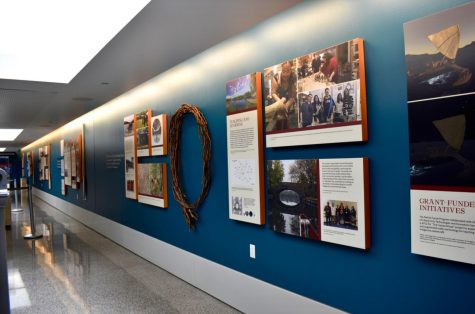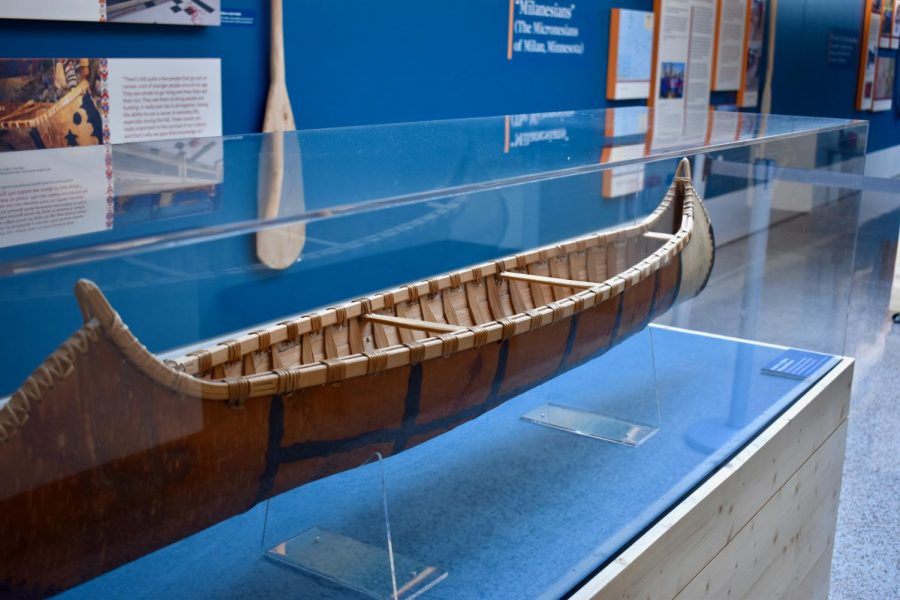To Jacob Bernier, a University of Minnesota graduate student, canoes carry not only passengers’ weight but also the weight of history.
“They have carrying capacity, and not just in the physical sense. They have the ability to teach and to help people to learn,” Bernier said. “That’s been something that’s been going on for millennia and will continue to do so. As long as there are people there will be canoes.”
Bernier is one of the student curators behind the newest exhibit at the Northrop Gallery “Why Canoes?,” an installment focusing on the function and cultural significance of Indigenous watercraft.
The exhibit highlights three Indigenous canoeing communities based around the Minnesota area and the work they are doing in canoe revitalization. Representing the Dakota, Ojibwe and Micronesian communities, the exhibit showcases the ways these groups are participating in not only the historical study of canoes but also in the contemporary construction and use of them.
Along with Bernier, the exhibit was co-curated by American Indian Studies professor Dr. Vicente Diaz and former University student Chrissy Goodwin.
The exhibit will remain available to the public through the end of the fall 2021 semester. Hours of operation are Monday through Friday from noon to 5 p.m.
Bernier is looking forward to the exhibit as an opportunity to highlight the work being done in partnership with the three communities.
“Honestly, everything has to start with a conversation. Speaking with different members of each community, [we are] just trying to have a better understanding of where they’re at with their revitalization efforts,” Bernier said. “Personally, I feel this exhibit has helped highlight what these communities are doing, and the work that communities are putting in to learn from each other.”

Much of the research used for the exhibit was based on work being done by the Native Canoe Program through their partnership with Indigenous communities. Founded and directed by Diaz, the group uses traditional Indigenous watercraft to advance community-engaged research, teaching and service.
Having worked closely with Diaz during his coursework in American Indian Studies, Bernier was inspired by the hands-on study of canoes that Diaz’s courses introduced him to.
“Jacob really threw himself into the material that we were looking at,” Diaz said. “He’s the kind of person that likes to be outside, he likes to work with his hands, and so it’s not surprising that he really took to the communities that were involved in canoe building.”
This appreciation for Bernier’s work ethic is echoed by University architecture professor and producer of “Why Canoes?” Greg Donofrio. He believes Bernier has helped create an experience that offers a valuable look into the lives and practices of local canoe communities.
“Part of what this exhibit tries to do is to understand what a canoe might mean from an Indigenous perspective,” Donofrio said. “It’s something much more than just a boat. It’s something that might be hard for many of us to understand but it’s [the exhibit] an incredible opportunity to try to see the world through a different set of eyes.”
For his final project in his Heritage Studies and Public History coursework, Bernier is working to create an online representation of “Why Canoes?” to be captured on a 360-degree camera. This virtual exhibition is set to be added to the Northrop website by the end of this semester.
“Honestly, it’s hard to try to really accurately represent [the importance of canoes to Indigenous communities] in an exhibit-type form because things are always changing. Work is constantly being done,” Bernier said. “To try to capture something in one picture or paragraph just is not enough. But we did do our best.”
Correction: A sentence from a previous version of this article has been edited to accurately characterize the exhibit’s relation to Bernier’s cultural heritage. Bernier is a Red River Métis descendant, which is not an Indigenous community highlighted in the exhibit.



















